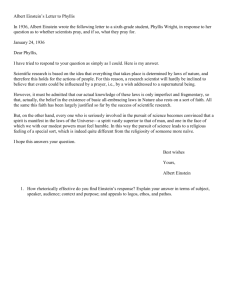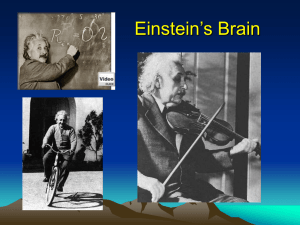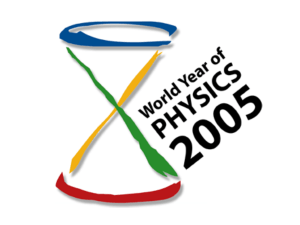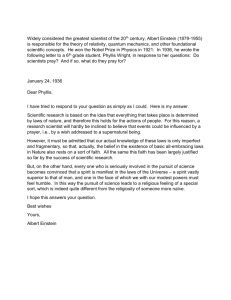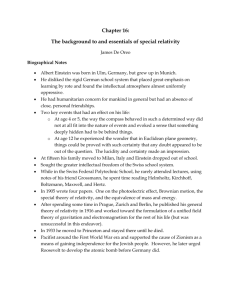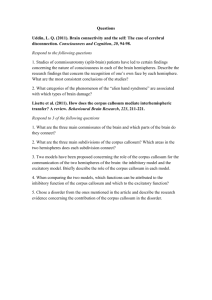Einstein brain 1100L - ojhs
advertisement
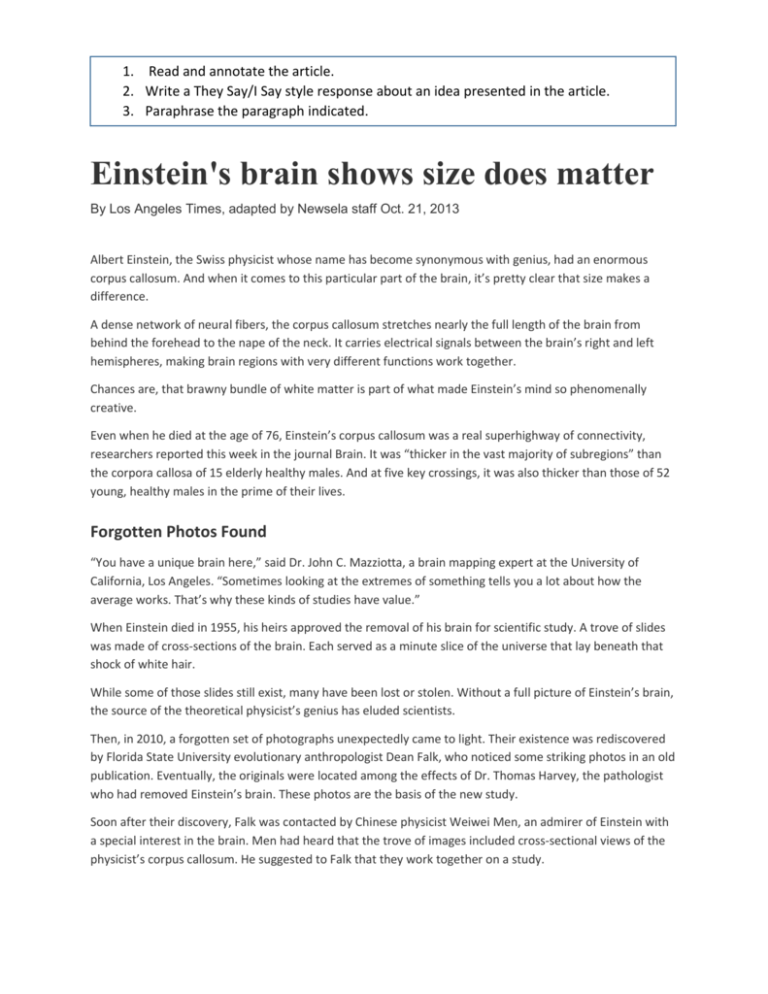
1. Read and annotate the article. 2. Write a They Say/I Say style response about an idea presented in the article. 3. Paraphrase the paragraph indicated. Einstein's brain shows size does matter By Los Angeles Times, adapted by Newsela staff Oct. 21, 2013 Albert Einstein, the Swiss physicist whose name has become synonymous with genius, had an enormous corpus callosum. And when it comes to this particular part of the brain, it’s pretty clear that size makes a difference. A dense network of neural fibers, the corpus callosum stretches nearly the full length of the brain from behind the forehead to the nape of the neck. It carries electrical signals between the brain’s right and left hemispheres, making brain regions with very different functions work together. Chances are, that brawny bundle of white matter is part of what made Einstein’s mind so phenomenally creative. Even when he died at the age of 76, Einstein’s corpus callosum was a real superhighway of connectivity, researchers reported this week in the journal Brain. It was “thicker in the vast majority of subregions” than the corpora callosa of 15 elderly healthy males. And at five key crossings, it was also thicker than those of 52 young, healthy males in the prime of their lives. Forgotten Photos Found “You have a unique brain here,” said Dr. John C. Mazziotta, a brain mapping expert at the University of California, Los Angeles. “Sometimes looking at the extremes of something tells you a lot about how the average works. That’s why these kinds of studies have value.” When Einstein died in 1955, his heirs approved the removal of his brain for scientific study. A trove of slides was made of cross-sections of the brain. Each served as a minute slice of the universe that lay beneath that shock of white hair. While some of those slides still exist, many have been lost or stolen. Without a full picture of Einstein’s brain, the source of the theoretical physicist’s genius has eluded scientists. Then, in 2010, a forgotten set of photographs unexpectedly came to light. Their existence was rediscovered by Florida State University evolutionary anthropologist Dean Falk, who noticed some striking photos in an old publication. Eventually, the originals were located among the effects of Dr. Thomas Harvey, the pathologist who had removed Einstein’s brain. These photos are the basis of the new study. Soon after their discovery, Falk was contacted by Chinese physicist Weiwei Men, an admirer of Einstein with a special interest in the brain. Men had heard that the trove of images included cross-sectional views of the physicist’s corpus callosum. He suggested to Falk that they work together on a study. Corpus Callosum's Splenium Last year, the two researchers were co-authors of a report that offered a remarkably detailed look at the organ’s surface. The brain’s extra folds showed evidence of unusual volume in a number of regions that were likely to have been essential to Einstein’s spatial and mathematical creativity. The high-resolution photos even revealed evidence of Einstein’s lifelong love of playing the violin: A large “knob” was found on the surface of the primary motor cortex. This is the region where the left hand is usually represented. The latest study is based on several of these same photographs, which showed the right hemisphere separated from the left. Those pictures revealed the corpus callosum with great resolution and accuracy. The researchers were particularly impressed by the brawn of one part of Einstein’s corpus callosum: the splenium. That region facilitates communication among the parietal, temporal and occipital lobes. The parietal and occipital lobes, in particular, are key to spacial and mathematical thinking. The splenium also keeps those regions in touch with the brain’s intellectual command center, the prefrontal cortex. Earlier studies of Einstein’s brain found some regions, notably the prefrontal cortex and the parietal lobes, were just plain bigger than those of normal people. But, the authors wrote, “Our findings suggest that Einstein’s extraordinary cognition was related not only to his unique cortical structure." It also involved "enhanced communications routes between at least some parts of his two cerebral hemispheres.” Strenuously Exercised His Brain According to Dartmouth College neuroscientist Peter U. Tse, the new report underscores something researchers now suspect: How and how much we use our brains may matter more as we age. Tse noted that, while Einstein’s brain was much more developed than those of similarly aged men, it was not so different from the brains of young and healthy men. That might reflect the fact that Einstein continued to exercise his brain strenuously. By doing so, he may have prevented much of the decline that usually comes with age. “It might just be that Einstein’s brain was more like a young person’s brain in that sense,” Tse said. “The brain is like a muscle, in the sense that neural circuits that are used often tend to change in their organization.” That, in turn, may shape connective tissues such as the corpus callosum, he added. “We should therefore not conclude that Einstein’s genius was caused by some part of his brain being slightly larger than average,” he said. “It might be that his brain was slightly larger in these areas because he exercised these regions more than the average person.” Alexander Schlegel, a fellow neuroscientist at Dartmouth, cautioned too that there is much more to genius than either cerebral brawn or ceaseless exercise of the gray matter. “I think it is unfair to Einstein to suggest that his specialness can be pared down to simple anatomical features,” Schlegel said. “In reality, much of what made Einstein so successful was the playfulness, curiosity and deep understanding he cultivated through a lifetime of hard work.”
